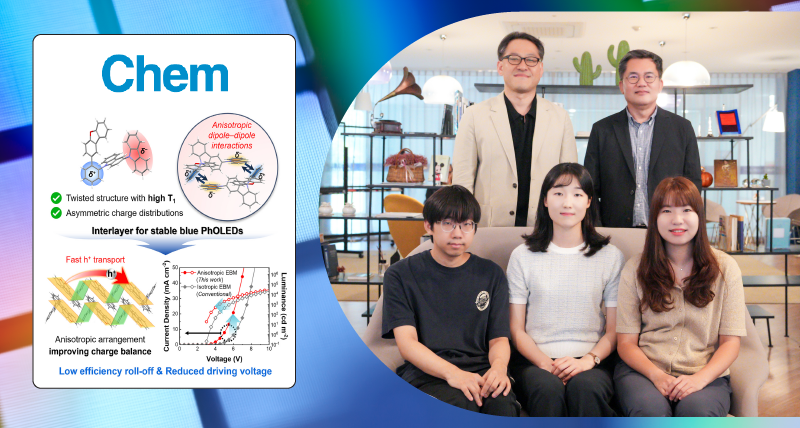A research team, affiliated with UNIST has introduced a groundbreaking organic semiconductor material that significantly enhances the luminous efficiency and stability of organic light-emitting diodes (OLEDs). This advancement is expected to expedite the commercialization of next-generation high-purity and high-efficiency display technologies.
This breakthrough has been led by Professor Tae-Hyuk Kwon and Professor Wonyoung Cho from the Department of Chemistry, in collaboration with Professor Jun Yeob Lee from Sungkyunkwan University (SKKU). The team has created a new interlayer material that addresses the longevity issues that have posed significant challenges for blue phosphorescent OLEDs (PhOLEDs).
The newly developed material notably reduced the driving voltage of OLEDs compared to previous iterations. Power efficiency improved by 24%, and operational stability increased by 21%. As an intermediate layer, it demonstrates applicability not only for blue OLEDs but also for next-generation inorganic-based light-emitting devices.
Phosphorescent OLED (PhOLED) technology utilizes a triplet-based light-emitting mechanism, making it possible to generate light more efficiently over extended periods. While red and green PhOLEDs have successfully reached the commercialization stage, the development of blue PhOLEDs has encountered challenges, including rapid device degradation, high driving voltages, and short lifespans that hinder commercialization.
The research team developed a new intermediate layer that reduces the driving voltage of blue PhOLEDs and minimizes light loss. Previous twisted molecular structures, while effective in triplet confinement, exhibited limited current flow. The new material addresses these limitations and enhances stability.
By strategically controlling the movement of electric charges and the properties of materials, the research team created an anisotropic arrangement. This design allows for more uniform distribution of electric charge while preventing light loss.
“It is quite unusual to achieve a herringbone arrangement in a twisted molecular structure,” noted first author Eunhye Hwang. “This represents a pivotal moment in the development of new organic semiconductor materials.”
Professor Kwon added, “We have proposed a novel strategy for developing intermediate layer materials that simultaneously address triplet confinement and charge balance, independent of the light-emitting layer. Based on this research, we aim to further advance the development of next-generation displays and light-emitting devices.”
The findings were published in the September 2024 issue of Chem, a sister journal of Cell. The research was supported by the National Research Foundation of Korea (NRF), the Korea Institute of Energy Technology Evaluation (KETEP), and UNIST.
Journal Reference
Eunhye Hwang, Unhyeok Jo, Jiyeon Kim, et al., “Anisotropy-guided interface molecular engineering for stable blue electroluminescence,” Chem, (2024).



